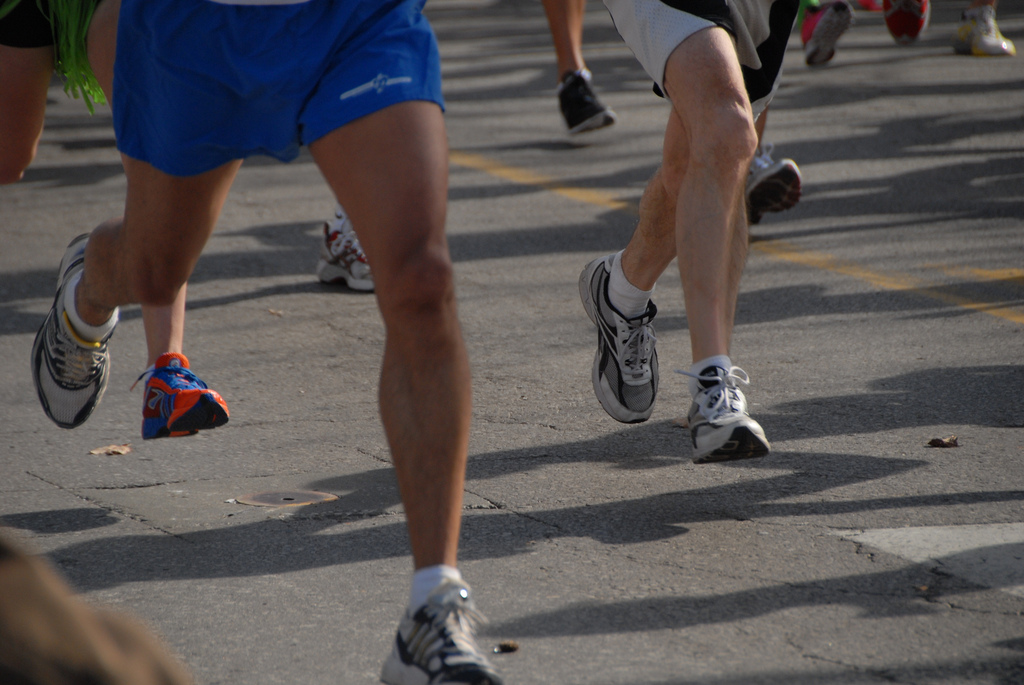 Health & Physiology
Health & Physiology
One run a day keeps the...cancer away!

A healthy life-style, including regular exercise, has long been associated with the prevention of diabetes and heart attack. Moreover, exercise helps to lower other major disease risk factors, e.g. obesity and high blood pressure. When it comes to cancer, it is suggested that exercise confers some protection, but to which extent, why, and how is largely unknown.
We recently set out to study if exercise would impact tumor incidence and growth in mice. Obviously, if one wishes to study a potential role of exercise using animal models it is crucial that the chosen animal is willing to exercise. With a simple running wheel in the cage, a mouse will voluntarily run between 4 and 8 kilometres per night, suggesting that mice are indeed good models for this kind of research.
We took several approaches to try and answer the question of the role of exercise in relation to cancer: first, we infected mice with skin cancer (melanoma) and lung cancer, respectively, and in both cases saw a significant delay in tumor growth in exercising animals. Secondly, we studied if exercise could lower the risk for development of cancer in the first place. Again, it was very clear that exercising mice had a lowered risk for development of tumors. Moreover, exercising mice that did get tumors had smaller tumors.
Exercise really had an astonishing impact on both tumor growth and development! How does that come about?
It is often believed that tumors consist of cancer cells only; however, they actually comprise numerous different cell types, including cells of the immune system. Interestingly, tumors from exercising mice contained much more immune cells, in particular a cell type called natural killer cells (NK cells). We could show that these NK cells play a key role by using mice that do not have them: in these mice, there was no anti-tumor effect of exercise.
Thus, natural killer cells are crucial; but how does exercise lead to increased NK cells numbers?
Exercise induces the secretion of a huge number of substances, amongst others the hormone adrenalin. Adrenalin exerts its function by interacting with receptors - so-called β-adrenergic receptors. When we blocked this interaction, NK cell levels did no longer increase by exercise and the anti-tumor effect was abolished.
So - the line of events leading to tumor control by exercise was revealed: (i) exercise leads to secretion of adrenalin; (ii) adrenalin interacts with β-adrenergic receptors (in the spleen); (iii) NK cells are mobilized and enter the blood stream; (iv) transported by the blood, NK cells reach the tumors; there, they kill cancer cells and attract more immune cells to the tumors.
Is this relevant for humans? We don't know that yet, but we think so. We know that exercise in humans also leads to increased NK cell numbers. Thus, exercise could play a role in preventing cancer in man.
To study such an effect in humans is not trivial because tumors develop over many years and are influenced by a range of different factors. One idea would be to take tumor biopsies before and after exercise. An increased number of NK cells after exercise - as seen in the mice - would strongly support the notion of an impact in humans.
Potentially, regular exercise could delay or prevent cancer in humans - time will tell. But could exercise have an immediate impact on cancer patients and treatments today?
Well - maybe it could. Several new treatments are based on a functional immune system, and it has been shown that patients with "immune-cell rich" tumors are more prone to benefit from those treatments. Consequently, huge efforts are undertaken to find ways by which the number of immune cells in tumors can be increased. If exercise could fulfil this role, it would likely be associated with a higher probability of response to treatment.
It really goes without saying that exercise is healthy. But with the potential described above, exercise could soon be incorporated into routine oncology, not only being important for living a long and healthy life but also as an integral part of optimal cancer treatment.
Original Article:
Pedersen, L., Idorn, M., Olofsson, G., Lauenborg, B., Nookaew, I., Hansen, R., Johannesen, H., Becker, J., Pedersen, K., Dethlefsen, C., Nielsen, J., Gehl, J., Pedersen, B., thor Straten, P. and Hojman, P. (2016).Voluntary Running Suppresses Tumor Growth through Epinephrine- and IL-6-Dependent NK Cell Mobilization and Redistribution. Cell Metabolism, 23(3), pp.554-562.Edited by:
Dr. Tobias Preuten , Editorial Advisor - Review operation manager
We thought you might like
Fighting back antibiotic resistance: a new hope from the soil
Feb 24, 2016 in Microbiology | 4 min read by Dan KramerThe colour beige: heating up the fat
Apr 1, 2016 in Health & Physiology | 3.5 min read by Caterina Da RèSERINC5: a blood cell guardian against HIV
May 13, 2016 in Health & Physiology | 3.5 min read by Massimo PizzatoHow early-life adversity gets under the skin
May 19, 2016 in Health & Physiology | 3.5 min read by Joanne RyanMore from Health & Physiology
Tobacco smoking and other exposures shut off cancer-fighting genes
Aug 31, 2024 in Health & Physiology | 3 min read by Jüri Reimand , Nina AdlerA hidden clock that times cytoplasmic divisions
Aug 30, 2024 in Health & Physiology | 3 min read by Cindy OwWhen two kinases go for a dance
Aug 2, 2024 in Health & Physiology | 4 min read by Ioannis Galdadas , Francesco Luigi Gervasio , Pauline JuyouxAwakening the thymus to cure SARS-CoV-2 infection: a matter of genes
Jul 27, 2024 in Health & Physiology | 3.5 min read by Stefano Marullo , Cheynier RemiKeeping the balance: How epigenetics monitors cancer genes
May 13, 2024 in Health & Physiology | 4 min read by Zach Gray , Madison Honer , Johnathan WhetstineEditor's picks
Trending now
Popular topics


